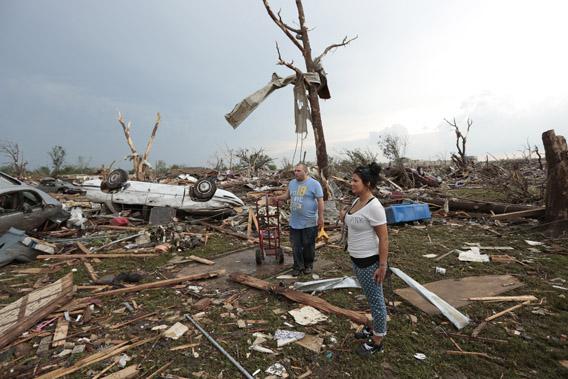A massive tornado struck the city of Moore, Okla., on Monday, killing dozens of people, with many still missing. Before Monday’s disaster, the Oklahoma City suburb was struck by major tornadoes in 1998, 1999, 2003, and 2010. Is there something about Moore that attracts twisters?
Not that we know of. Moore is in “Tornado Alley,” the vaguely defined region where warm, moist air at ground level often combines with cooler air aloft. That mixture, along with a high jet stream, makes thunderstorms and tornadoes very common, especially in spring. But there’s nothing specific about Moore that makes it more vulnerable to large twisters than, say, Oklahoma City (10 miles to the north), Norman (10 miles to the south), Chickasha (35 miles southwest), or Seminole (50 miles east). Where a massive tornado touches down within a tornado-prone region appears to be largely a matter of chance.
Topography can affect smaller tornadoes. The heavily forested mountains of central and western Pennsylvania, for example, disrupt funnel clouds and sometimes prevent tornadoes of size F2 or below from reaching the ground. (Read this for a description of how meteorologists measure tornado strength.) The massive twisters that have struck Moore in recent years, though, are fully capable of brushing aside ground-level obstructions. Buildings are even less likely to affect a tornado. Moore’s footprint has expanded in recent years, increasing the likelihood that a twister will touch down in a developed area. But humans can’t build anything large enough to attract or disrupt a large tornado.
Historical data from the National Weather Service suggests that the city of Moore should experience one tornado of size F2 or larger every 2,000 to 5,000 years. In fact, Moore has suffered through six since 1999. The recent run of bad luck may be a statistical quirk, but it’s also possible that the historical data are faulty. Reliable tornado records stretch back only to the 1950s. Since large tornadoes are a rare event, that’s a pretty small sample size on which to base a prediction. (Researcher Tom Grazulis has attempted to expand the database by reviewing news reports as far back as 1880, but the database still doesn’t compare to the centuries of detailed information we have about earthquakes and other natural disasters.) Our understanding of the relative frequency of tornadoes is likely accurate—Oklahoma does seem to get several times as many large tornadoes as California—but we’re not able to reliably predict how often a major tornado should strike a region.
Moore isn’t the only city to suffer unexpectedly frequent large tornadoes. The area around Huntsville, Ala., which should see a large tornado every 5,000 to 10,000 years, experienced an F4 tornado in 1989 and an F5 in 2011. Jefferson County, Ala., which includes the city of Birmingham, has seen five major tornadoes since 1950, and Tuscaloosa has suffered through six. In fact, researchers now believe that an area of the Southeastern United States that they call “Dixie Alley” may be even more prone to major twisters than the more famous Tornado Alley in the plains.
Got a question about today’s news? Ask the Explainer
Explainer thanks John T. Snow of the University of Oklahoma.
